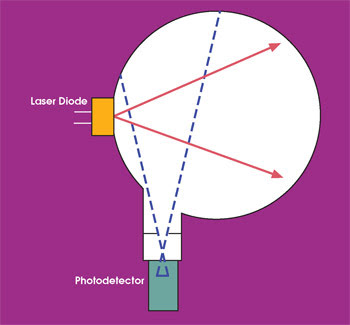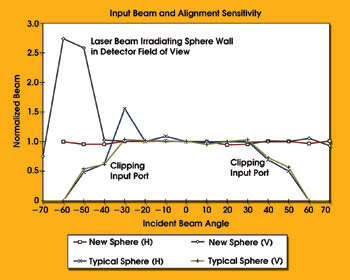Greg McKee, Labsphere Inc.
In the past few years, laser applications and, consequently, laser manufacture have experienced a significant increase. Although the upsurge has been driven primarily by telecom’s explosive growth, the rising medical and industrial laser markets also have contributed. This progress emphasizes the need for continuing improvement in the area of optical power measurement for these systems and devices. Inaccurate measurement can cause acceptable devices to be rejected, effectively reducing production yield or forcing companies to widen the window of acceptance.
Laser test and measurement is a blend of two distinct skill sets: optical and electrical engineering. This is a problem for end users who are not skilled in system development, or who simply don’t have the time to devote to it. The lack of repeatability and reproducibility makes laser testing even more difficult.
Although thermal detectors or vacuum tubes can make accurate optical power measurements, slowness and nonuniform active areas make them less than ideal for nonresearch applications. Many end users have tried to avoid this issue by using power meters that couple an integrating sphere with an Si, Ge or InGaAs photodiode.
In the typical integrating sphere, the detector is mounted at 90° around the circumference from the entrance port. The detector field of view is not limited, essentially collecting the sphere radiance over a broad solid angle. The objective of the sphere is to collect only the integrated radiance from the sphere wall. The sphere is baffled to avoid the first strike of the beam, which is caused when a laser strikes the sphere and creates a hot spot on the first bounce. It can also be baffled to avoid direct radiation caused by aiming the laser over the active area of the detector.
Aberrations in measurement results can happen with some beam geometries, depending on whether the laser under test is positioned for repeatability. Repeatable test results can be obtained when both the sphere and the laser are clamped, so that the physical arrangement is exactly the same from one laser to the next. When skilled operators conduct the tests in this way, problems are only occasional. In practice, however, testing often is performed by less experienced technicians.
It can be time-consuming to acquire guaranteed repeatable measurements. One method employs an electrically calibrated pyroelectric radiometer to measure the laser diodes. Although this device is standard, it requires a chopper for signal conditioning and a 15-minute warm-up period to allow for temperature stabilization, a delay that is not conducive to productivity. In addition, extra care must be taken to avoid damaging the sensitive detector coating.

Figure 1. In the integrated sphere solution, the photodiode is positioned orthogonally to the entrance port and closer to the entrance-port plane.
The development of a radiometer that is fast and whose integrating sphere design is optimized to minimize alignment errors that occur when measuring highly divergent laser diodes solves these problems. To achieve this task, a highly diffuse and reflective interior coating was required. Although essential for most applications, the internal baffle or screen was removed because it can cause shadowing in the sphere, enhancing the spatial nonuniformities (Figure 1).
The solid angle subtended from the photodiode was reduced to 0.05 sr, which served two purposes. First, it limited the field of view to a small, fully integrated light sample that did not include the hot spot of light from first reflection. And second, the radiometer achieved an optical attenuation of 40 dB, avoiding the probability of saturating or damaging the photodiode (Figure 2).

Figure 2. Spatial testing results show that this design achieved its purpose.
Realizing the design’s potential, the company quickly adapted it to serve the needs of the laser and laser diode industries. Today hybrids of this design can be found in laboratories, on production floors and on burning racks throughout the world.
Meet the author
Greg McKee is manager of product marketing at Labsphere Inc. in North Sutton, N.H.; e-mail: [email protected].